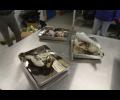
By Megan Gannon
Last Friday morning, Gay Sheffield was packing a cooler in the science lab at the University of Alaska Fairbanks’ Northwest Campus in Nome. She was not preparing for a weekend at camp. Rather, she was sending frozen birds, including a rare spectacled eider, to the U.S. Geological Survey National Wildlife Health Center to be tested for avian influenza.
Sheffield, who is an agent for UAF Alaska Sea Grant’s Marine Advisory Program, has been fielding local concerns over the last several weeks about a highly pathogenic strain of the virus that has been spreading through domestic poultry and wild birds in North America. Health officials say that the risk to humans remains low, with only one confirmed infection in a person in the U.S, but at least 40 million birds have now been killed in domestic flocks where infections were detected across the country. The spread of the virus is not nearly as well monitored in wild birds, but it has been detected in several species in Alaska, and even in foxes.
Without a campaign to actively test birds in the Bering Strait region, state and federal agencies are relying on reports from the public about sick and dead birds. Several opportunities presented themselves this past week.
Most notably, a strangely behaving spectacled eider was reported at Fort Davis. This striking duck, which is on the Endangered Species List, has a green head and white eye patches that make it look like it’s wearing glasses. Sheffield got a call late one night after someone’s dog grabbed the duck, which the caller reported was already acting lethargic. That frozen duck specimen was sitting alongside a few other birds Sheffield had collected. She had a pair of half-processed murres sent in by subsistence hunters from Savoonga who were concerned about a green discoloration of the meat. She also had a glaucus gull, found near death in the surf at Safety Sound.
Her work for the weekend wasn’t finished Friday. On Saturday, Sheffield was out enjoying the Midnight Sun Festival with other Nomeites when she got a call from a parade-goer. A skinny, weak and confused looking crested auklet had wandered into the parade action on Front Street.
Crested auklets—prized for their meat, eggs, and their tangerine-orange bills and dangling crest of feathers on their heads—are usually found offshore and in colonies on islands like Little Diomede this time of year. It was strange for the bird to be in Nome, and even stranger for it to show up in the middle of a parade, Sheffield said. The bird was still warm when this reporter stopped by the lab Saturday as Sheffield prepared to freeze it and send it away for tests, which she hoped would provide answers.
In the latest update to its list of avian flu confirmations, the Alaska State Veterinarian’s office has said that infections have been confirmed in the Bethel area and the Yukon Delta in several species, including glaucous gulls, Sabine’s gulls, brants and cackling geese. Those confirmations, however, lagged days or weeks behind reports of birds that were showing signs of sickness.
To report unusual observations and concerns about birds, call the U.S. Fish and Wildlife Service Alaska Sick/Dead Bird Hotline at 1-866-527-3358. Reports can also be posted to the Local Environmental Observer Network, www.leonetwork.org or locally to Gay Sheffield, UAF Alaska Sea Grant at (907) 434-1149. Foxes or other wild mammals behaving abnormally or found dead can be reported to the Alaska Department of Fish and Game at dfg.dwc.vet@alaska.gov.







